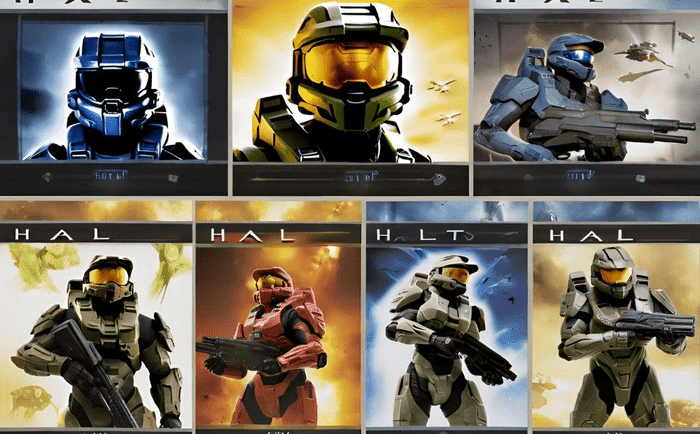When you think of video game icons, the legendary “Halo” series probably comes to mind. But have you ever stopped to consider what truly makes these icons halo (2003) game icons banners and banners from the 2003 release stand out? In a game as influential as Halo, even the smallest details like icons and banners play a major role in shaping its identity. Let’s dive deep into what makes these visuals not just graphics, but an integral part of the Halo experience.
The Significance of Visual Design in Gaming
In the early 2000s, game developers were just starting halo (2003) game icons banners to recognize the importance of cohesive visual elements like icons and banners. For Halo: Combat Evolved, released in 2003, the creators took this to heart, crafting visuals that were not only functional but also visually striking. The icons and banners weren’t just slapped together; they were meticulously designed to capture the essence of the game while enhancing the overall user experience.
The primary purpose of these elements was to guide halo (2003) game icons banners players through the game. Whether it was navigating the main menu, selecting multiplayer options, or customizing your in-game settings, the icons and banners served as intuitive guides. However, they did much more than just act as buttons—they became a visual representation of the game’s identity.
The Halo Icon: Simplicity Meets Symbolism
One of the standout features of Halo’s icons is their minimalist halo (2003) game icons banners yet impactful design. For a game steeped in a rich sci-fi universe, the icons had to reflect that futuristic tone. The designers opted for sharp, clean lines, geometric shapes, and subtle metallic textures that echoed the game’s setting. When you see a Halo icon, you’re instantly reminded of the game’s atmosphere—cold, strategic, and high-tech.
Yet, these icons also carry a deeper layer of symbolism. halo (2003) game icons banners Take the well-known shield icon, for instance. Not only does it represent protection in the game, but it also visually ties into the broader theme of the Halo universe, where safeguarding humanity is the primary mission. The icons strike a delicate balance between being functional in a gaming context and enriching the lore of the game itself.
Banners That Set the Tone
If the icons set the game’s functional tone, then the halo (2003) game icons banners banners are what give Halo its visual flair. Banners in Halo serve multiple roles. They’re not just decorative—they’re central to branding, event announcements, and in-game achievements. The banners from the 2003 Halo installment were particularly impactful because they were designed to be bold and eye-catching while maintaining a sense of military precision.
One key aspect of these banners is how they incorporate halo (2003) game icons banners the game’s distinct color palette. The use of deep greens, gunmetal grays, and hints of blue immediately sets a militaristic tone. Even if you’ve never played Halo, seeing these banners gives you a clear understanding that this is a game about tactical combat in a futuristic setting.
The Evolution of Icons and Banners Across the Series
While the focus is on the 2003 version, it’s fascinating to see halo (2003) game icons banners how the design elements of icons and banners have evolved over the years. In the early days, the designs were more straightforward, reflecting the limited technology available at the time. However, as technology advanced and Halo continued to release more games, the visuals became more refined while still retaining the core elements introduced in the 2003 game.
Despite the evolution, there remains a consistent thread in the halo (2003) game icons banners designs that link each title back to the original. This consistency isn’t accidental; it’s a deliberate choice to maintain the brand’s identity across different generations of gamers. By sticking to key motifs like the shield icon and the signature color schemes, the Halo series has ensured that even with updates, fans can always recognize the iconic look of the franchise.
Why These Visual Elements Matter
You might wonder—why place so much emphasis on icons and halo (2003) game icons banners banners in a video game? For starters, these elements contribute heavily to a game’s user interface (UI). A cluttered or confusing UI can ruin even the best gaming experiences. Halo avoided that pitfall by designing icons and banners that are easy to understand, intuitive to use, and visually appealing. Even non-verbal communication within the game is enhanced by these elements.
Furthermore, these visuals also play a key role in marketing. halo (2003) game icons banners The banners used in promotional materials, on websites, and within the game itself are often the first thing players see. For the 2003 release, those banners set the tone for what players could expect—a high-stakes, action-packed adventure. In many ways, they served as the game’s first impression, and as the saying goes, you never get a second chance to make a first impression.
The Nostalgia Factor
For long-time fans of the series, the icons and banners from the halo (2003) game icons banners 2003 Halo game hold a special place in their hearts. These visuals are more than just game assets—they’re tied to memories of late-night gaming sessions, intense multiplayer battles, and the thrill of finishing a mission. The emotional connection players have with these elements speaks volumes about their importance. It’s not just about playing a game; it’s about experiencing a world where even the smallest details evoke a sense of nostalgia and excitement.
Crafting Icons and Banners for Future Games
As gaming continues to evolve, the need for thoughtful visual design remains as important as ever. Future Halo titles will likely continue the trend of building on the foundation set by the 2003 installment. However, they will also need to innovate and adapt to changing player expectations and advancing technology. While keeping the iconic look intact, there’s always room for adding halo (2003) game icons banners new textures, 3D effects, and interactive elements that enhance the user experience even further.
But at the core, the principles laid down in 2003 will likely persist—clarity, functionality, and a design that resonates deeply with the game’s lore. Future designers will have to strike that delicate balance between paying homage to the past while pushing the boundaries of what’s possible.
Conclusion: The Lasting Legacy of Halo’s Visual Design
The icons and banners from Halo (2003) aren’t just relics of the past; they are essential components of the series’ enduring legacy. They helped define the visual identity halo (2003) game icons banners of the game in ways that still resonate today. With their clean design, symbolic depth, and strong branding, these visual elements set a standard for how game interfaces should be approached. Whether you’re a hardcore Halo fan or someone who’s just curious about game design, it’s clear that these icons and banners played a pivotal role in making Halo the iconic series it is today.
So, next time you boot up a Halo game, take a moment to halo (2003) game icons banners appreciate the icons and banners. They’re more than just visuals; they’re a reflection of the thought, creativity, and passion that went into crafting a game that has stood the test of time.


